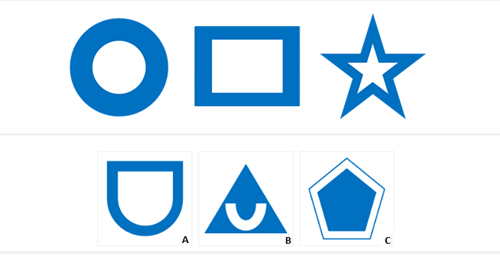CogAT test is conducted to check the level of cognitive development students as per their age and grade. This test measures three different cognitive abilities of the student – verbal, quantitative, and nonverbal section. In the verbal section, students are tested for their ability to transform the sequences of English words. They are thoroughly tested for their overall understanding of the English language.
The quantitative section focuses on the child’s understanding of the basic quantitative concepts as well as relationships. In the nonverbal section, students are tested for their reasoning ability with the help of geometric shapes and pictures.
These three sections of the tests are known as batteries and at the end of the test, students are graded with the average score of all three batteries which is known as the composite score. Taking maximum CogAT practice tests can certainly help your child to score good grades.
Let’s understand how the CogAT test is administered and evaluated. Let’s begin!
Modes of Test
The CogAT
The test is administered in a group but can also be taken individually, if
required. It is generally administered by the homeroom teacher. It is
administered in 3 ways: online testing, paper, and pencil testing with central
scanning of answer documents and paper and pencil testing with local scanning
of answer documents.
The Local scanning of answer documents and online testing requires the Houghton Mifflin Harcourt data manager system. It is the official online resource for managing the assessment programs. Form 8 is the latest version of CogAT which is equivalent to form 7, the previous version.
About the test
The CogAT test consists of 14 levels with varying difficulty levels. Here the question types, number of questions and the length of the test varies according to the level. The level of the test depends upon the child’s age.
CogAT test consists of multiple-choice questions and the maximum number of students that can take the test at a time are 20. The segments or the batteries can administer
either individually or separately.
It is recommended to check with the school regarding the pattern of the test. You can ask questions such as what kind of mode it would be, online or with paper and pencil. You can ask whether all the batteries would be attempted together or separately. Also, do not forget to confirm the appropriate level for your child.
About CogAT levels
As discussed, the tests are assigned to the students according to their age and
grade. Each level of the test is meant for a different grade, has different
questions and the test duration.
It starts with the 5th and 6th level which is for the students in Kindergarten. They have to attempt 118 questions in total (all three batteries) in 112 minutes.
The level 7 test is assigned to 1st-grade students. It has 136 questions and they get 112 minutes to solve them.
2nd-grade students have to attempt level 8. It has 154 questions
and they get 122 minutes to attempt the test. Here the Quantitative batteries
consist of Number series, Number Analogies, and Number Puzzles. The verbal
batteries consist of Sentence completion, Picture classification, and Picture analogies. The nonverbal battery consists of Paper folding, Figure classification, and Figure Matrices.
The level 9 test is assigned to a 3rd-grade student. They are given 170 questions and with a total duration of 90 minutes. The test structure is similar to grade 2.
4th-grade students are assigned level 10 tests. It has a total of 176 questions. They get 90 minutes to solve it.
At Level 11, 5th-grade students are assigned 176 questions with a total time of 90 minutes.
6th-grade students are offered the test of level 12 with 176 questions. They need to attempt this test within 90 minutes.
Level 13 and Level 14 tests are assigned to 7th and 8th grades respectively. Here they need to solve 176 questions within 90 minutes.
9th and 10th-grade students are given the tests of Level 15 and Level 16 respectively. They need to solve 176 questions in 90 minutes.
Here comes the final one. The Level 17 and Level 18 tests are assigned to the students of 11th and 12th grade. They need to attempt this set of 176 questions within the time frame of 90 minutes.
Evaluation of the Test
The pattern of the score shows the overall understanding of your child. The evaluation is classified in various profiles ranging from A profile, B profile, C profile, and D profile. The A profile indicates that the performance of your child is the same across all the batteries. Profile B shows that the score of one of the batteries is higher than the other two. C profile indicates that there is a very little difference between the scores of all three batteries while the E profile shows that there is an extreme difference of more than 24 points between all three batteries.
Misconception about CogAT administrations
There are some misconceptions that people have in their minds about CogAT administration. Let’s get to know it in detail.
CogAT scores are equivalent to the IQ
CogAT is not administered to evaluate anyone’s ability and hence it is not related to the IQ level of the students.
CogAT score remains the same for all the age groups
CogAT test level differs as per the age group. Though the test pattern remains the same across all age groups, every age group has certain levels of tests and different questions as per the level. Hence as per the level, the child needs to reappear for the test.
CogAT helps to measure the capacity of the student
CogAT helps teachers and the institutes to check the student’s ability to perform in various subjects but that does not mean that it gives the assurance or the prediction about your child’s overall capacity.
CogAT is against the minorities
This is another great misconception most parents have. CogAT is administered within groups of students and it is evaluated by a diverse panel of the institute. Hence every student is evaluated and administered at an equal level.
Discussion of the results
It is always advisable to discuss the results with the student according to their performance and level. It is not recommended to discuss the result with the kindergarten, grade 1, and grade 2 students as they might not recollect what they have written in the test and at this age, they do not understand the importance of the test or the results. Hence you can completely skip in this case. For grade 3 and grade 5 where students generally understand little about the test and the results, you can discuss the same with them. You can discuss their score in terms of the performance. Here you can also mention to them about their particular strength which they need to work on. Let’s talk about grade 6 to grade 12 students. Here at this level students are well aware of the test structure as well as the results. They need to make choices for their further education on the basis of these test scores. You can discuss the scores with them and also make sure they know their particular strength.













